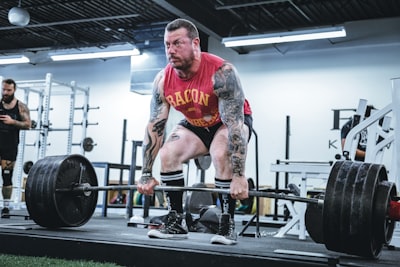Beginner’s Guide: How to Gain Muscle Fast

Key Highlights
- Building muscle requires consistent effort in terms of strength training and a proper diet.
- To stimulate muscle growth, focus on compound exercises, proper nutrition, and adequate rest.
- Beginners should start with lighter weights and gradually increase the intensity to avoid injuries.
- Protein is crucial for muscle repair and growth, so ensure you’re consuming enough through your diet or supplements.
- Don’t get discouraged if you don’t see results immediately; building muscle takes time and patience.
- Listen to your body, take rest days when needed, and seek guidance from fitness experts when necessary.
Introduction

Want to gain muscle mass and improve your body? Building muscle with strength training is a journey that needs regular work, good food, and enough rest. This guide will help beginners by showing a clear path to faster muscle growth. It includes important information on how muscle building works, the best type of exercise for building muscle, the best way to create effective workouts, and tips for better nutrition.
Understanding Muscle Growth

Muscle growth is also known as muscle hypertrophy. This process is very interesting. When you do strength training, you make tiny tears in your muscle fibers. But don’t worry! These micro-tears help start the repair process in your body.
While you recover, your body fixes these micro-tears by joining muscle fibers together, leading to an increase in muscle size. This process, known as muscular hypertrophy, is crucial for building muscle. Many factors, such as hormones like testosterone and growth hormone, genetics, and nutrition, can affect this process of muscle growth. Understanding muscular hypertrophy and how it relates to muscle growth is essential for anyone looking to gain muscle fast.
The Science Behind Gaining Muscle

Muscle hypertrophy is the process of making muscle fibers bigger. This process has several steps. It starts with resistance training, which puts stress on muscle fibers and causes some damage.
After this damage, the body reacts with inflammation. Even though inflammation doesn’t sound good, it is a normal part of building muscle. This response helps activate special cells called satellite cells.
Satellite cells are found on the outer side of muscle fibers. They help repair muscles by multiplying and joining with the damaged fibers. They add their nuclei and help with muscle growth. This also boosts protein synthesis, which helps increase muscle hypertrophy even more.
Factors Affecting Muscle Growth
Genetics are very important in how well someone can build muscle. Some people naturally have more fast-twitch muscle fibers. These fibers can grow more than slow-twitch fibers.
Hormones are also key for muscle growth. Testosterone and growth hormone play big roles. Testosterone helps protein synthesis and boosts satellite cell activity. Growth hormone supports tissue growth and repair.
Resistance training is the main way to build muscle. Regular strength training activities, like lifting weights or doing bodyweight exercises, are important to start the muscle-building process.
Preparing for Your Muscle-Building Journey

Before you start your muscle-building journey, it’s important to have a strong foundation. This means learning the basics of strength training, setting achievable goals, and having the right equipment.
Building muscle takes time. It needs your consistency and patience, so don’t feel disheartened if you don’t see quick results. If you stay dedicated to your training, you will enjoy the benefits of more strength, a better body, and improved overall health.
Essential Equipment for Beginners

Investing in a simple home gym can be very useful for beginners. A set of free weights, like dumbbells and barbells, is very important for doing compound exercises. Adjustable dumbbells are great since you can change the weight as you get stronger.
Weight machines help guide your movements. This is helpful for beginners who are still learning how to use proper form. Some common weight machines are leg presses, chest presses, and shoulder presses.
Resistance bands are a good and low-cost option for free weights and machines. They come in different levels of resistance and can be used for many exercises.
Setting Realistic Goals

Before you begin your muscle-building program, it’s important to have realistic expectations and clear goals. Don’t compare yourself to experienced weightlifters. Everyone begins somewhere, and getting better takes time.
Talk to a certified personal trainer or a healthcare professional. They can help you find a good starting point based on your fitness level, body type, and any health issues you may have.
Begin with a workout plan that is easy to handle. As you get stronger, slowly increase how hard or how often you train. Be patient, stay consistent, and keep a positive attitude. These things are very important for your success in building muscle.
The Beginner’s Guide to Effective Workouts

A good workout plan is important for building muscle. First, learn the basic rules of strength training. After that, you can add harder exercises.
Focus on exercises that use several muscle groups at once. This helps with muscle development and burns more calories. Pay attention to your body. Make sure to take enough rest and recover well between your workouts.
Step 1: Mastering the Basics of Strength Training

Beginners should focus on learning the correct form before trying to lift heavy weights. Start with bodyweight exercises like push-ups, squats, and lunges. These will help you build a strong base and connect your mind to your muscles.
Take on compound exercises. These work multiple muscle groups at the same time. Squats, deadlifts, bench presses, overhead presses, and rows are great examples. They help make muscle growth better by giving you a strong workout.
Look for help from a certified personal trainer or watch videos that show proper form, breathing techniques, and safe ways to lift weights. Using the correct form is very important. It helps prevent injuries and ensures your muscles work well.
Step 2: Incorporating Compound Movements

Compound exercises are very important for building muscles. They work many muscle groups at the same time. Some good examples of these exercises are squats, deadlifts, bench presses, and overhead presses. These moves help with overall muscle development and burn more calories.
The squat is often called the “king of exercises.” It mainly targets the quads, hamstrings, glutes, and core. This exercise is great for gaining lower body strength and muscle mass.
The bench press is another key compound exercise. It mainly works the chest, shoulders, and triceps. If you add these exercises to your routine, you will be on your way to reach your muscle-building goals.
Step 3: Understanding Workout Splits

Workout splits help you focus on different muscle groups each day. This way, your muscles can rest and recover well between workouts. Some popular splits are push-pull-legs, upper-lower, and full-body routines.
In a push-pull-legs split, you work on push exercises on one day, pull exercises on another day, and legs on a separate day. This gives your muscles good recovery time and makes sure each group gets enough attention.
An upper-lower split, on the other hand, splits workouts into upper body and lower body. You can pick a split that fits your goals, how experienced you are, and how well you recover.
Step 4: Gradually Increasing Intensity
Progressive overload is key for muscle growth. It means you should slowly increase how much work your muscles do over time. You can do this by lifting heavier weights, doing more sets and reps, or taking shorter breaks between sets.
As your muscles get used to the workout, you need to make it harder to keep improving. Pay attention to your body and don’t overdo it, as this could cause injuries.
A good strength training program has deloading periods. During these times, you lower the amount of training or the intensity. This helps your body recover and stop your progress from stalling.
Nutrition for Muscle Gain

Nutrition is very important for muscle building. To boost muscle growth and help your body recover, eat a balanced diet. This diet should have plenty of protein, carbohydrates, and healthy fats.
Protein is known as the building block of muscles. It gives your body the amino acids needed for muscle repair and growth. Make sure you get enough protein in your diet.
The Role of Protein in Muscle Building
Protein is very important for building and fixing tissues, like muscle tissue. If you do strength training, getting enough protein helps your muscles recover and grow. Try to have about 0.8 grams of protein for every pound of your body weight each day.
Great sources of dietary protein are lean meats, chicken, fish, eggs, dairy, beans, lentils, and nuts. These foods have all the amino acids your body needs for muscle protein synthesis.
You might think about adding protein shakes or supplements, like whey protein or casein protein, to your diet. This can be helpful if you have a hard time getting enough protein from normal foods.
Carbs and Fats: Getting the Balance Right
Carbohydrates are the main source of energy for your workouts. They provide the fuel your body needs for intense training sessions. Choose complex carbs like brown rice, quinoa, oats, and sweet potatoes. These foods release energy slowly and give you steady fuel all day long.
Dietary fat used to get a bad reputation, but it is very important. Healthy fats help with hormone production, cell function, and good health. Add healthy fats to your diet with avocados, nuts, seeds, and olive oil.
Getting the right balance of macronutrients—protein, carbohydrates, and fats—is key for improving body composition. It also supports muscle growth and helps you stay healthy overall.
Supplements: Are They Necessary?
Supplements aren’t a quick fix, but they can help you improve your diet and build muscle. Protein powder, like whey protein, is a simple way to increase your protein intake. This is especially useful if you find it hard to get enough protein from regular foods.
Creatine is a substance that your body makes naturally. It can help you perform better in exercise and support muscle growth. This is because it increases phosphocreatine, which is a key energy source in muscle cells.
The world of supplements is huge and can be confusing. There are many products that promise a lot. It’s important to look for trustworthy brands. You should also talk to a healthcare professional or a registered dietitian before you start taking any supplements.
Recovery Strategies for Faster Muscle Growth
Recovery is as important as your workouts for muscle growth. Good recovery helps your muscles repair and rebuild. This leads to better results over time.
Make sure to get enough sleep and drink plenty of water. Activities like walking or stretching can also help with muscle recovery. These practices can reduce soreness and boost your overall performance.
Importance of Rest Days
Don’t ignore how important rest days are. It might seem strange, but taking breaks from training is very important for helping muscle growth and stopping overtraining.
When you rest, your muscles can really heal from the small tears they get during workouts. Good rest helps your body gain back energy, fix hurt tissues, and grow muscles.
Too much training can cause tiredness, sore muscles, lower performance, and a higher chance of injuries. Adding rest days to your workout plan lets your body deal with training stress better and helps you make progress over time.
Sleep and Muscle Recovery
Getting enough sleep is very important for muscle recovery and good health. When you sleep, your body produces growth hormone. This hormone helps repair tissues and build muscles.
Try to get 7-9 hours of good sleep every night. This will help with muscle recovery and support your muscle growth. Make your bedroom dark, quiet, and cool to create a good sleep environment.
Set a regular sleep schedule. Go to bed and wake up around the same time every day, even on weekends. This helps your body keep its natural sleep rhythm, which improves the quality of your sleep.
Overcoming Common Challenges
Every fitness journey has its challenges. Plateaus, which are times when you seem to stop making progress, often happen. Don’t let these stop you from moving forward!
Injuries can also hold you back, but if you deal with them right away and work on getting better, you can get back to reaching your goals. Keep in mind that being consistent, patient, and staying positive is important to get past these challenges.
Dealing with Plateaus
Plateaus are a common part of getting fit, but they can be frustrating. The good news is that there are helpful ways to push past these plateaus and keep moving forward.
One strategy is adaptive resistance. This means you keep challenging your muscles by adding more weight, reps, or sets over time. When you do this, your muscles have to adapt and get stronger.
You can also try advanced training techniques. Options like drop sets, supersets, or rest-pause sets can help give your muscles a surprise to encourage growth. Always listen to your body and change your workout based on how you feel.
Preventing Injuries
Preventing injuries is very important for everyone who loves fitness. A good way to avoid getting hurt is to keep the right form when exercising.
Make sure to warm up well before your workout and cool down after. This helps your muscles get ready for training and lowers the chance of strains or tears. Stretching often can also help you become more flexible and move better, reducing the chance of injury.
If you do get injured, talk to a healthcare professional. Physical therapy is important for healing, allowing you to recover strength, movement, and function.
Conclusion
To sum up, starting a journey to grow muscle needs a well-rounded approach. This includes science, workouts, nutrition, and recovery plans. By learning about muscle growth and setting realistic goals, you set yourself up for success. It’s important to balance protein, carbs, and fats, and think about if you need supplements. Don’t forget that rest days and good sleep are very important for muscle recovery. You will face challenges like hitting plateaus and avoiding injuries, but that is part of the process. Stay committed, patient, and consistent. With time, you will see progress in achieving your muscle-building goals.
Frequently Asked Questions
How Long Does It Take to See Muscle Growth?
It’s normal to wonder when you’ll see results from your hard work. Muscle development can be different for everyone, depending on things like genetics and how hard you train. Usually, you can start to see visible changes in skeletal muscle within a few weeks of regular training. Bigger changes will happen over several months and years. So, remember, patience is essential because building muscle takes time.
Can You Gain Muscle Without Weights?
You can definitely build great muscle mass without using any weights. Bodyweight exercises, like calisthenics, use your body weight as resistance. This creates muscle tension that helps with growth. Exercises such as squats, push-ups, lunges, and planks work your muscles. They adapt and get stronger to handle what you ask of them.
What Is the Best Time of Day to Work Out for Muscle Gain?
Some studies say that hormone levels change during the day. This can affect how well your workouts work. However, the best time to exercise for muscle gain depends on what you like and how often you can do it. Pick a time that fits your daily sleep cycle, energy, and schedule. This way, you can keep working out consistently.
https://www.ncbi.nlm.nih.gov/pmc/articles/PMC7889060
https://www.health.harvard.edu/drugs-and-medications/testosterone–what-it-does-and-doesnt-do
